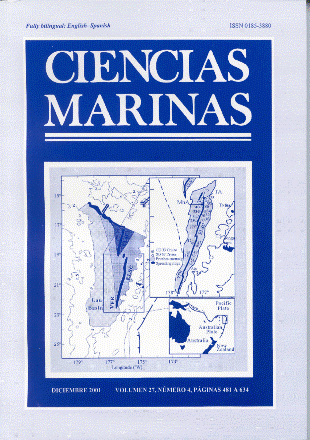Biology and fishery of the arched box crab Calappa convexa de Saussure (Crustacea, Brachyura, Calappidae) In the Southeastern Gulf of California, Mexico
Main Article Content
Abstract
The arched box crab (Calappa convexa) is commonly caught in gillnets as by-catch of the spiny lobster (Panulirus spp.) fishery in southern Sinaloa, Mexico, a locally exploited fishing resource. Crabs were sampled monthly from May 1998 to April 1999 and a total of 274 specimens (132 males and 142 females) were captured. The distribution of the resource was homogeneous (present in 72% of the samples) throughout the sampling area. The overall sex ratio (female:male) was 1:0.92 (χ2 > 0.05). The capture per unit effort (CPUE) varied from 0.81 g/100m2/h to 9.10 g/100m2/h. Maximum catch was obtained in June while minimum catches occurred in December and March. The CPUE values differed significantly (ANOVA P < 0.05) among the months of sampling. Crabs were caught on sand, rock and boulders, with 43% of the CPUE corresponding to rocky substrate. Mean size, based on carapace length (CL), was 72.5 ± 5.8 mm for males and 74.5 ± 7.2 mm for females. Individual size frequency distribution was unimodal and normal in males and unimodal and not normal in females, with the largest number occurring in spring (107) and winter (73). Reproduction occurred throughout the year, with peaks from April to August. Females reached sexual maturity at an estimated size of 75 mm (CL–50) and carried an average of 638,885 eggs. The mean size differed significantly between females (75.7 mm CL, SD = 7.3 mm) and males (72.8 mm CL, SD = 5.8 mm) (P < 0.05). The modal classes displayed a slight seasonal displacement (spring to winter) towards larger sizes. Analysis of the carapace width:length relationship shows variation during male and female development, specifically, in larger sizes (> 75 mm CL), females were narrower while the opposite occurred in males. Left and right chelae reached a combined fresh weight of 100 g, in males of about 75.0 mm CL, while in females this weight was reached at 79.0 mm CL.
Downloads
Article Details
This is an open access article distributed under a Creative Commons Attribution 4.0 License, which allows you to share and adapt the work, as long as you give appropriate credit to the original author(s) and the source, provide a link to the Creative Commons license, and indicate if changes were made. Figures, tables and other elements in the article are included in the article’s CC BY 4.0 license, unless otherwise indicated. The journal title is protected by copyrights and not subject to this license. Full license deed can be viewed here.

